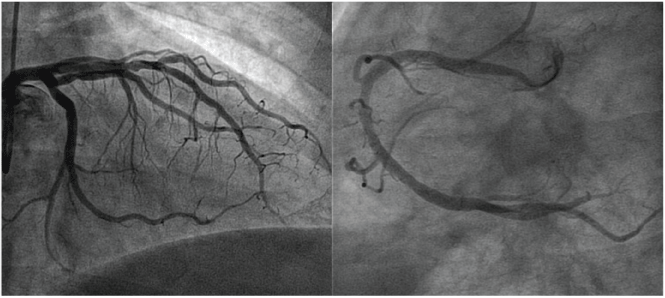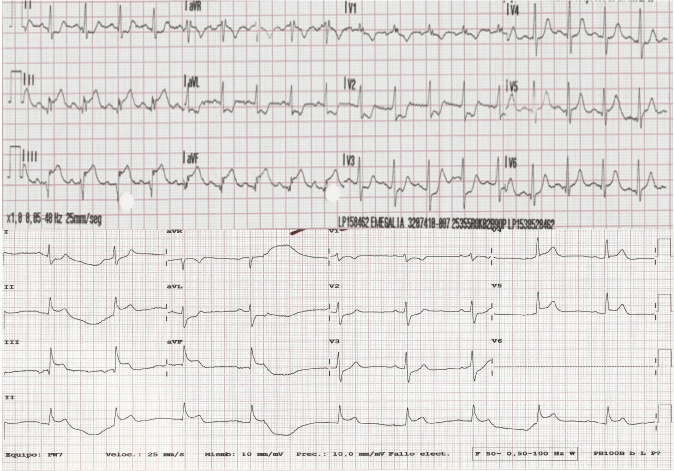International Journal of Clinical Cardiology
Methyl-Ergonovine Stress Echocardiography in the Study of Kounis Syndrome due to Anisakis Simplex: A Case Report
Jorge A Restrepo, Jorge Salamanca, Guillermo Diego, Fernando Rivero, Fernando Alfonso and Rio Aguilar*
Department of Cardiology, Hospital Universitario de La Princesa, Madrid, Spain
*Corresponding author: Rio Aguilar, Department of Cardiology, Hospital Universitario de La Princesa, Calle Josep Pla 16, 6°A, Madrid, Spain, 28002, Tel: +34 655080531, E-mail: rioaguilar@pulso.com
Int J Clin Cardiol, IJCC-2-056, (Volume 2, Issue 5), Case Report; ISSN: 2378-2951
Received: September 09, 2015 | Accepted: October 07, 2015 | Published: October 10, 2015
Citation: Restrepo JA, Salamanca J, Diego G, Rivero F, Alfonso F, et al. (2015) Methyl-Ergonovine Stress Echocardiography in the Study of Kounis Syndrome due to Anisakis Simplex: A Case Report. Int J Clin Cardiol 2:056. 10.23937/2378-2951/1410056
Copyright: © 2015 Restrepo JA, et al. This is an open-access article distributed under the terms of the Creative Commons Attribution License, which permits unrestricted use, distribution, and reproduction in any medium, provided the original author and source are credited.
Case Report
A 51-year-old man, smoker (20 packs-year) with no known allergies and no medical history of previous symptoms or cardiovascular disease. Two hours after eating a raw fish dish of hake and prawn, the patient presented intense oppressive chest pain, dyspnea, diaphoresis, abdominal pain, diarrhea, nausea and vomit. He was first attended by the prehospital emergency medical service after 24 minutes of onset of symptoms; initial physical exam: Paleness, diaphoresis, rhythmic heartbeat at 100 b.p.m, blood pressure 78/48 mmHg with no signs of heart failure; electrocardiogram (ECG) showed sinus tachycardia and 3 mm ST-segment elevation in inferior limb leads and ST-segment depression consistent with and reciprocal changes in leads I, aVL, V1-V3, no Q waves were present. The patient was diagnosed with inferior acute ST elevation myocardial infarction (STEMI) and then referred to our hospital for undergoing primary percutaneous coronary intervention and was treated with acetylsalicylic acid 500 mg, Clopidogrel 300 mg and isotonic saline solution.
Forty minutes after the symptoms had begun, upon arrival in the hemodynamic room, the symptoms and ECG alterations disappeared spontaneously. The coronary angiogram performed in the first hour of evolution did not show any lesions (Figure 1). The aortography, ventriculography and the echocardiogram were normal. During the first hours, the patient presented generalized urticarial skin rash and fever (39°C), and was treated with antihistamine drug, Dexchlorpheniramine 2 mg twice a day. The acute phase reactants as High sensitive C reactive protein 1.2 mg/dL (normal < 0.8) and white blood cell 10280/cc and partial differential count Neutrophils 50.2% were normal and no infection or bacteremia were found. The T-Ultrasensitive Troponin T was elevated 450 ng/L (normal < 14 ng/L), with normal Creatine Phosphokinase 186 U/L. The patient progressed favourably. As the clinic and electrocardiographic findings were suggestive of coronary vasospasm (CV), he was empirically treated with calcium channel blockers Diltiezem 120 twice a day and nitroglycerin patch 10mg/24 hours with no recurrence of symptoms. A Methyl-ergonovine Stress echocardiography (MESE) was performed with increasing doses of Methergin every three minutes; MESE was echocardiographic, electrically and clinically positive on the fourth level (0.4 mg). Inferior and lateral dyskinesia was presented in transthoracic echocardiogram (TTE), ECG showed inferior and V4-V6 leads ST-segment elevation, with specular image ST-segment depression in I, aVL and V1-V3; reproducing the initial ECG (Figure 2). A few seconds later by the onset of previous findings these changes diminished with 100 mcg of IV Nitroglycerin.
Based on the CV diagnosis and the anaphylactic reaction following the raw fish intake, it was suspected a Kounis Syndrome Type I, which was supported by documenting mast-cell activation after quantifying increased serum tryptase level 15.4 ug/L (upper normal value 13.5 ug/L) and hypersensitivity due to Anisakis simplex (AS) employing prick test 10 × 9 mm, as well as serum total IgE 804 KU/L (normal < 100) and specific IgE against AS 68.5 KU/L (upper limit 3.5) quantification.
Discussion
The third Universal definition of myocardial infarction [1] classifies the myocardial infarction in five types, including CV as Type II. This type is defined as the imbalance between the oxygen demand and supply, when there is or no coronary atherosclerosis. The pathophysiology that explains the CV is not completely known in Kounis Syndrome Type I; however, it has been demonstrated that stimuli as ergonovine and histamine can generate it. Histamine is an important inflammatory promoter able to produce through receptors H1 and H2-by releasing endothelial nitric oxide-vasodilation, the increment of the vascular permeability, and reduction of the vascular peripheral resistance, arterial hypotension, decrease the cardiac output, tissue hypoperfusion and myocardial ischemia. In addition to this, histamine has a direct vasoconstrictor action over the coronary arteries (receptor H1) and is able to promote and enhance the platelet aggregation to induce the release of proinflammatory cytokines [2].
As is a nematode that acts as a fish parasite. It infects humans accidentally when raw or undercooked fish contaminated with larvae is consumed. Infection may cause digestive disorders: nausea, vomiting, abdominal pain, appendicitis, bowel blockage or bleeding. AS may also be responsible of an allergic form similar to other allergic reactions to food and can trigger even anaphylaxis [3]. The sensitization rates to AS in the general population range from 0.4% to 10%. Allergic reactions may be triggered by dead parasites being able to release of proinflammatory cytokines and vast amounts of histamine.
The patient simultaneously presented hypersensitivity and typical coronary manifestations two hours after the raw fish intake; we made a presumptive diagnosis of a gastrointestinal clinic syndrome secondary to AS according to the syndrome described by Kounis et al. [4] as "syndrome of the allergic angina". This syndrome explains how the concurrence of allergic and angina stimuli can even generate a myocardial infarction (allergic myocardial infarction).
The Kounis Syndrome (KS) is defined as the acute coronary syndrome related to a mastocytosis degranulation, platelet activation and the secondary inflammatory cells interaction with hypersensitivity reactions. The KS is classified into three types [5]. Type I: CV that can progress to myocardial infarction in patients with no cardiovascular risk factors and with normal coronary arteries. Type II: isolated CV or associated with plaque rupture or erosion, when preceded by quiescence coronary atherosclerosis. Type III: Stent thrombosis due to allergy to the stent components and when eosinophil and mastocyte cells are found after thromboaspiration. In the present case no coronary lesions were documented and thus it was classified as KS Type I.
The MESE is an alternative to demonstrate CV once lesions coronary at the angiogram have been discarded. This non-invasive method has the advantage of avoiding both vasomotor tone changes induced by the catheter and potential allergic reactions and nephrotoxicity due to iodine contrasts. Besides, segmental wall motion alterations in the TTE represent an additional index of severity to the ECG and clinical evaluation, after the provocation of myocardial ischemia [6]. These facts can be seen in this case, where after MESE the clinic and electrocardiogram recordings of the first incident were reproduced and solved after I.V. Nitroglycerin.
References
-
Thygesen K, Alpert JS, Jaffe AS, Simoons ML, Chaitman BR, et al. (2012) Third Universal Definition of Myocardial Infarction. Circulation 126: 2020-2035.
-
Coppola G, Caccamo G, Bacarella D, Corrado E, Caruso M, et al. (2012) Vasospastic angina and scombroid syndrome: a case report. Acta Clin Belg 67: 222-225.
-
Audicana MT, Kennedy MW (2008) Anisakis simplex: from obscure infectious worm to inducer of immune hypersensitivity. Clin Microbiol Rev 21: 360-379.
-
Kounis NG, Zavras GM (1991) Histamine-induced coronary artery spasm: the concept of allergic angina. Br J Clin Pract 45: 121-128.
-
Kounis NG (2013) Coronary hypersensitivity disorder: the Kounis syndrome. Clin Ther 35: 563-571.
-
Song JK, Park SW, Kang DH, Hong MK, Kim JJ, et al. (2000) Safety and clinical impact of ergonovine stress echocardiography for diagnosis of coronary vasospasm. J Am Coll Cardiol 35: 1850-1856.







